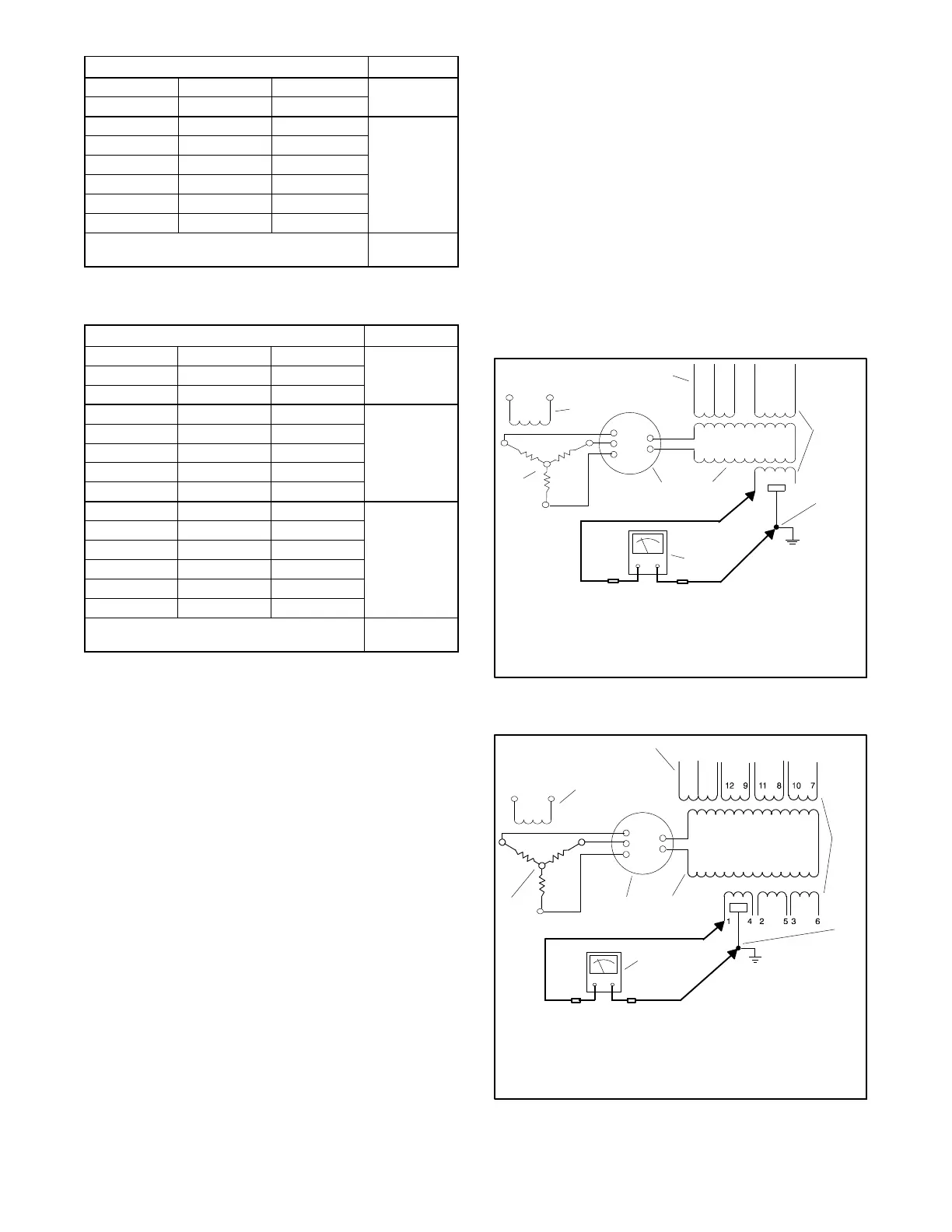TP-6953 7/19180 Section 10 Alternator Component Testing and Adjustment
Leads Continuity
1 and 2 3and4 —
Yes
60 and 61 61 and 62 60 and 62
1 and 3 1and4 —
No
2 and 3 2and4 —
1 and 60 1 and 61 1 and 62
2 and 60 2 and 61 2 and 62
3 and 60 3 and 61 3 and 62
4 and 60 4 and 61 4 and 62
Any stator lead and ground on stator housing or
frame laminations
No
Figure 10-12 Stator Continuity Test Results on a Good
Stator (Single Phase)
Leads Continuity
1 and 4 2and5 3and6
Yes
7 and 10 8and11 9and12
60 and 61 61 and 62 60 and 62
1 and 2 1and3 1and7
No
1 and 8 1and9 2and3
2 and 7 2and8 2and9
3 and 7 3and8 3and9
7 and 8 7and9 8and9
1 and 60 1and61 1and62
No
2 and 60 2and61 2and62
3 and 60 3and61 3and62
7 and 60 7and61 7and62
8 and 60 8and61 8and62
9 and 60 9and61 9and62
Any stator lead and ground on stator housing or
frame laminations
No
Figure 10-13 Stator Continuity Test Results on a Good
Stator (Three Phase)
5. Check the cold resistance of the stator windings by
connecting the meter leads to the stator leads as
shown in Figure 10-12 or Figure 10-13. See
Section 1, Spec if ications, for the stator resistance
values. If the stator resistance test is inconclusive,
perform a megohmmeter test on the stator as
described in the next step.
Note: Consider the stator functional if the
resistance reading (continuity) is low and
there is no evidence of shor ted windings
(heat discoloration).
Note: When taking an ohmmeter reading using
leads 60, 61, or 62, make the connection
beforethefuseifused.
Note: The stator resistance can vary directly with
increased temperature.
If any of the stator readings vary during the
previous checks, replace the stator.
6. Check the stator for a short-to-ground condition
using a megohmmeter. See Figure 10-14 for a
single-phase megohmmeter connections and
Figure 10-15 for three-phase megohmmeter
connections.
Apply 500 volts DC to any stator lead from each
winding and the stator frame. Follow the
megohmmeter manufacturer’s instructions for
using the megohmmeter. Repeat the test on the
other leads until all of the stator windings have
been tested. A reading of 1.5 MOhms and higher
indicates the stator is functional. A reading of less
than 1.5 MOhms indicates deterioration of the
winding insulation and possible current flow to
ground; if so, repair or replace the stator.
1
5
6
7
8
9
62
61
34
12
FN FP
3
2,
4
TP-6878-3
1. Auxiliary power for exciter field and
voltage regulator
2. Voltage sensing (A, B, and NEU)
leads (208- 240 volts nominal)
3. Stator windings
4. Main field (rotor)
F+
F-
AC
AC
AC
60
5. Rectifier module
6. Frame connection
7. Megohmmeter
8. Exciter armature
9. Exciter field winding
M
Figure 10 -14 Megohmmeter Connections on Stator
(Single Phase)
62
61
TP-6878-3
1
2,
6
3
45
7
8
FN FP
9
1. Auxiliary power for exciter field and
voltage regulator
2. Voltage sensing
(A,B,C,andNEU)leads
(208- 240 volts nominal)
3. Stator windings
F+
F-
AC
AC
AC
60
4. Main field (rotor)
5. Rectifier module
6. Frame connection
7. Megohmmeter
8. Exciter armature
9. Exciter field winding
M
Figure 10 -15 Megohmmeter Connections on Stator
(Three Phase)

